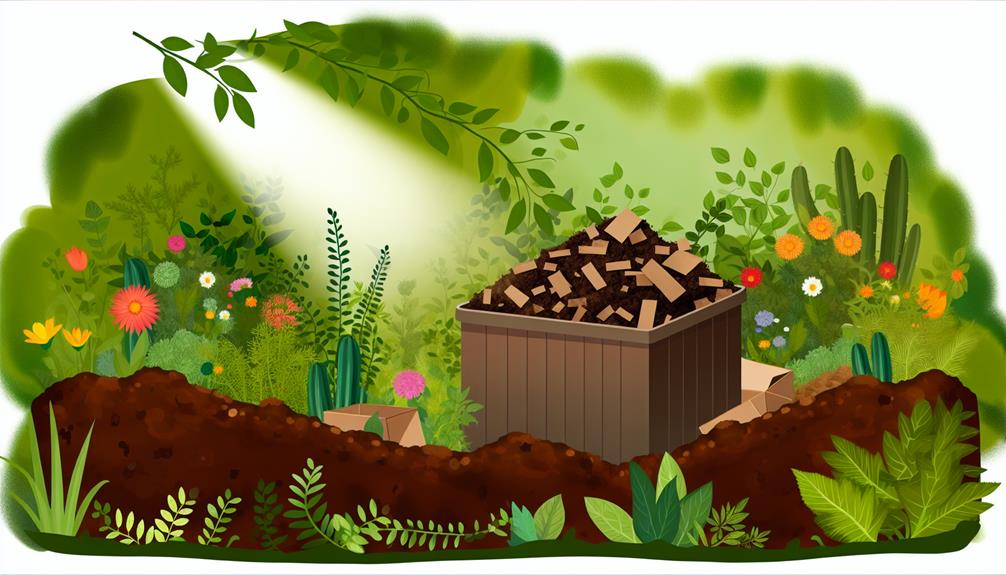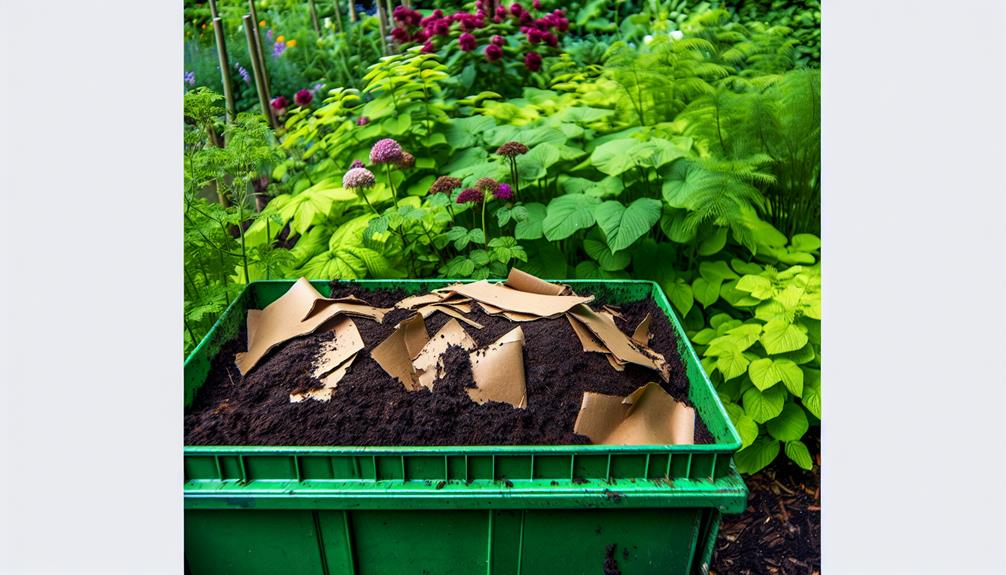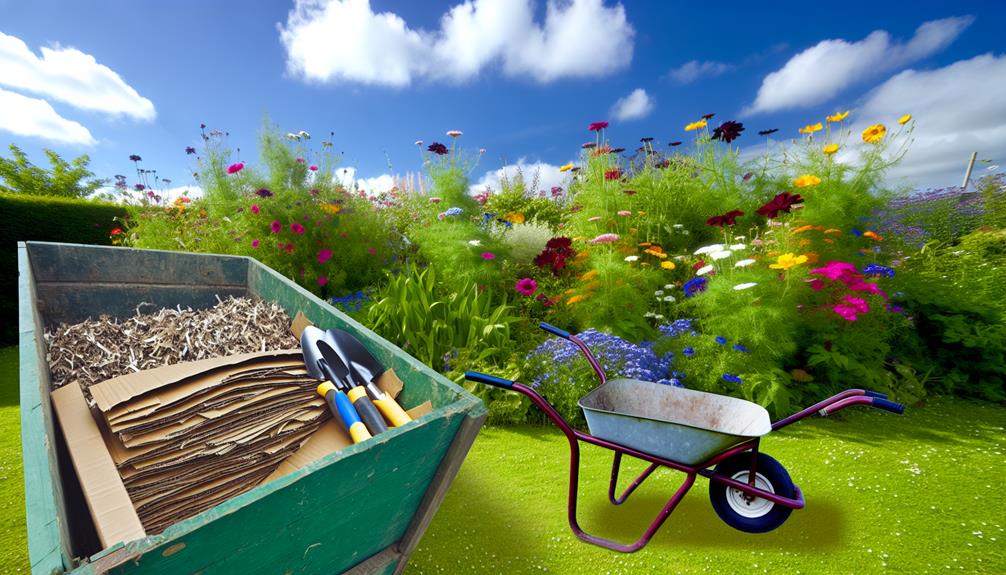

Yes, you can compost cardboard, and it’s a fantastic way to enrich your compost pile! Stick to corrugated and flat cardboard, avoiding shiny or coated types. Shred it into small pieces to speed up decomposition, and mix it with nitrogen-rich materials like kitchen scraps. Cardboard boosts aeration, retains moisture, and enhances soil structure, making your compost more effective.
Remember to remove tape and stickers before composting. With regular turning, shredded cardboard can break down in about two months, providing a rich, balanced compost that benefits your garden. Ready to transform waste into nutrient-rich compost? There’s more to explore!
You’ll find several types of cardboard suitable for composting, each bringing unique benefits to your compost pile. Embracing these options lets you reduce cardboard waste while enriching your compost.
Here are some key types worth exploring:
Ensure you remove any tape or stickers before adding cardboard to your compost. By choosing the right types of cardboard, you can effectively manage cardboard waste and contribute to a healthier compost system.
Using cardboard in your compost pile offers several impressive benefits!

First, it enhances soil structure, creating a well-balanced and nutrient-rich environment for plants.
Additionally, cardboard retains moisture effectively, which helps maintain the right conditions for decomposition, while also reducing waste volume by keeping cardboard out of landfills.
Ever wondered how adding cardboard to your compost can dramatically improve soil structure? Incorporating cardboard, a carbon-rich material, into your compost balances the nitrogen-rich components, striking the perfect harmony for efficient decomposition. This balance is crucial in enhancing decomposition rates, ensuring that your compost breaks down effectively and enriches your soil.
By adding cardboard, you’re not just discarding waste but fostering a healthy garden ecosystem. It helps create a well-structured soil, providing aeration for beneficial microorganisms.
Boosts aeration: Enhances oxygen flow, promoting microbial activity.
Balances nutrients: Combines carbon-rich and nitrogen-rich materials effectively.
Improves texture: Breaks down to form crumbly, fertile soil.
Embrace the power of cardboard in your compost and watch your garden thrive!
Alongside improving soil structure, adding cardboard to your compost also greatly enhances moisture retention, aiding in the breakdown process. When you incorporate cardboard, particularly corrugated types, it holds moisture effectively, creating a perfect environment for beneficial microorganisms. These microorganisms thrive in moist conditions, accelerating the decomposition of organic materials.
By shredding the cardboard and layering it properly, you guarantee consistent moisture levels, which is crucial for efficient decomposition. This not only speeds up the composting process but also helps maintain a balanced and healthy ecosystem within your compost.
Embracing cardboard in your compost pile connects you to a community of eco-conscious individuals committed to sustainable practices and a thriving garden.
Composting cardboard greatly reduces waste volume in landfills, helping to prevent around 7 million tons of cardboard from ending up as waste annually. When you add cardboard to your compost pile, you’re not just cutting down on cardboard waste; you’re also enriching your compost with carbon. This carbon is essential for balancing the compost pile and helps speed up decomposition.
By composting cardboard, you contribute to a more sustainable environment and create nutrient-rich compost that benefits your garden. Here are some reasons to compost cardboard:
Also Read: Can You Compost Almond Shell?
To compost cardboard effectively, start by shredding it into small pieces to speed up decomposition. Composting cardboard is easier when you shred cardboard and layer it with high-carbon materials like leaves or straw. Adding water mixed with liquid detergent helps break down the cardboard even faster. Turning the compost pile every five days aids in efficient decomposition. Cardboard adds essential carbon to your compost, balancing nitrogen-rich materials for best decomposition.
Here’s a quick guide:
| Step | Action | Purpose |
|---|---|---|
| 1. | Shred | Speeds up decomposition |
| 2. | Layer | Balances high-carbon materials |
| 3. | Soak | Breaks down quicker |
| 4. | Turn | Assists in breakdown |
| 5. | Balance | Ensures prime composting |
Follow these steps, and you’ll see your cardboard composting smoothly!
Shredding cardboard greatly reduces its decomposition time to about two months. Large cardboard naturally decomposes in 6-8 months, but shredding it helps it decompose as quickly as other compost materials.
Properly managing your compost heap can make a big difference in how fast cardboard waste makes its way back into the soil.
Also Read: Can You Compost Barbecue Sauce?
Shredding cardboard for composting offers numerous benefits. It speeds up decomposition and ensures even carbon distribution. You should prepare by cutting or ripping the cardboard into small, manageable pieces. This enhances its breakdown and mixing with other compost materials.
Effective shredding methods, along with some safety tips, will help you achieve the best results in your compost pile.
By shredding cardboard for compost, you greatly accelerate the decomposition process. When you shred paper and boxes, you increase their surface area, making it easier for microbes to break them down in your compost pile. This not only speeds up decomposition but also fosters a healthier compost environment.
Shredded cardboard integrates seamlessly with other compost ingredients, leading to a more balanced compost pile. It enhances moisture retention and airflow, preventing your compost from becoming too dry or compacted. Shredding guarantees a more even distribution, allowing for consistent decomposition throughout the pile.
To guarantee efficient and safe shredding of cardboard for compost, start by removing any tape, labels, and staples to prevent contamination and machinery damage.
Once clean, soak the cardboard in water with a bit of liquid detergent to help break it down faster. Shredding it into small pieces will also speed up decomposition.
When adding shredded cardboard to your compost, layer it with soil and high-carbon materials like dry leaves or straw. This combination ensures the cardboard works effectively. Remember to balance it with nitrogen-rich items like grass clippings.
Regularly turn the compost pile every five days to maintain even breakdown. Following these steps ensures your cardboard in compost integrates smoothly and efficiently.
One of the most effective ways to prepare cardboard for composting is by cutting it into small strips, which greatly enhances its surface area for faster decomposition. Shredding cardboard helps mix it well with other compost materials, creating a balanced compost heap.
Smaller cardboard pieces decompose more evenly and quickly compared to larger, intact pieces, ensuring efficient composting.
Here are some methods to shred cardboard effectively:
Also Read: Can You Compost Alcohol?
Transforming cardboard boxes into compost is a straightforward process that can greatly enhance your garden’s soil. Begin by breaking the cardboard into small pieces to speed up decomposition.

Layering shredded cardboard with nitrogen-rich materials, like manure, creates a balanced compost heap. This mix guarantees that the cardboard breaks down efficiently, enriching your compost with valuable nutrients.
To accelerate the process, soak the cardboard in water mixed with liquid detergent before adding it to your pile. This helps break down the fibers faster.
Regularly turning your compost pile every five days ensures even decomposition. With dedication and a bit of effort, you’ll find your compost heap turning into rich, nutrient-filled soil in just six to eight months.
Consider adding kitchen scraps, such as fruit and vegetable peels, to your compost pile to enhance its nutrient content. To make the most of your compost bin, follow these additional tips:
Shredding cardboard guarantees it integrates well with other materials, creating a rich, balanced compost. Regularly aerating the compost pile allows oxygen to speed up decomposition, turning kitchen scraps and cardboard into nutrient-rich compost. These steps help reduce landfill waste, promote sustainability, and enrich your garden soil.
You shouldn’t compost shiny or coated cardboard, especially if it contains plastic. Avoid cardboard with heavy dyes, paint, or harmful chemicals. Remove any plastic tape, labels, or stickers before composting to prevent contamination.
You should definitely put cardboard in your compost. Just make sure it’s uncoated and free of dyes, tape, and labels. Composting cardboard reduces landfill waste and enriches your soil, fostering a sustainable and eco-friendly community.
To prepare cardboard for composting, break it into small pieces, soak it in water with liquid detergent, and make sure it’s free of non-biodegradable elements. Layer it with dried leaves, and turn the compost every five days.
You can add a significant amount of cardboard to your compost, but balance it with green materials like kitchen scraps. Shred or tear it into small pieces and layer it to promote even decomposition, enriching your compost.
So, you can definitely start composting cardboard! It’s a fantastic way to recycle and enrich your compost pile. Remember to choose the right types, shred it for faster decomposition, and mix it well with other compost materials.
By doing this, you’re not only reducing waste but also boosting the health of your soil. Embark on cardboard composting and watch your garden thrive—it’s simple, eco-friendly, and incredibly rewarding!
